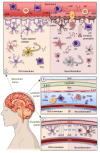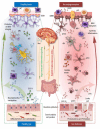Bridging the brain and gut: neuroimmune mechanisms of neuroinflammation and therapeutic insights
- PMID: 40584220
- PMCID: PMC12202344
- DOI: 10.3389/fncel.2025.1590002
Bridging the brain and gut: neuroimmune mechanisms of neuroinflammation and therapeutic insights
Abstract
The central nervous system (CNS) and the immune system are profoundly interconnected, engaging in a continuous dynamic exchange that regulates homeostasis, immune surveillance, and responses to injury. These interactions occur through diverse mechanisms, ranging from microglial activation and cytokine signaling to peripheral immune cell infiltration. When disrupted, this balance contributes to neurodegenerative processes, affecting cognitive function and neuronal survival. This mini-review examines the cellular and molecular foundations of neuroimmune communication, focusing on how neuroimmune interactions influence the onset and progression of neurodegenerative disorders such as Alzheimer's disease. Key mechanisms include barrier systems, gut-brain interactions, and circadian rhythm regulation, all playing a crucial role in modulating neuroinflammatory responses. The gut-brain axis plays a pivotal role in modulating CNS function, as alterations in gut microbiota composition can trigger neuroinflammatory pathways, affect systemic immunity, and influence disease susceptibility. Both innate and adaptive immune responses are instrumental in shaping disease trajectory, highlighting the complex interplay between systemic and neural immune components. The blood-brain barrier and glymphatic system modulate immune cell trafficking and waste clearance, influencing CNS pathology. Additionally, circadian rhythm and sleep patterns regulate neuroimmune balance, with disruptions exacerbating inflammation and neurodegeneration. Neuroimmune crosstalk manifests through a spectrum of pathways, each capable of either promoting resilience or accelerating neurodegeneration. By unraveling these connections, we can gain new insights into potential strategies to modulate immune responses and restore homeostasis. This investigation underlines the necessity of integrative approaches that target immune modulation, microbiota regulation, and circadian alignment to mitigate neurodegenerative disease progression and improve therapeutic outcomes.
Keywords: AD; cytokines; glial cells; gut-brain interactions; immune cells; neurodegenerative diseases; neuroinflammation; neurons.
Copyright © 2025 Müller and Di Benedetto.
Conflict of interest statement
The authors declare that the research was conducted in the absence of any commercial or financial relationships that could be construed as a potential conflict of interest.
Figures


Similar articles
-
Unraveling the Gut-Brain-Immune Interplay in Herpes Simplex Virus-Associated Neurodegeneration.J Med Virol. 2025 Aug;97(8):e70504. doi: 10.1002/jmv.70504. J Med Virol. 2025. PMID: 40704582 Review.
-
Dysbiosis and Neurodegeneration in ALS: Unraveling the Gut-Brain Axis.Neuromolecular Med. 2025 Jul 3;27(1):50. doi: 10.1007/s12017-025-08870-0. Neuromolecular Med. 2025. PMID: 40608189 Review.
-
Exploring the Role of Microglial Cells in the Gut-Brain Axis Communication: A Systematic Review.J Neurochem. 2025 Jul;169(7):e70154. doi: 10.1111/jnc.70154. J Neurochem. 2025. PMID: 40662222 Free PMC article. Review.
-
The Interplay Between Exosomes and Gut Microbiota in Neuroinflammation: A New Frontier in Alzheimer's Disease.Int J Mol Sci. 2025 Jun 18;26(12):5828. doi: 10.3390/ijms26125828. Int J Mol Sci. 2025. PMID: 40565291 Free PMC article. Review.
-
The Inflammasome-miR Axis in Alzheimer's Disease and Chronic Pain: Molecular Mechanisms and Therapeutic Opportunities.Aging Dis. 2025 Jun 25. doi: 10.14336/AD.2025.0353. Online ahead of print. Aging Dis. 2025. PMID: 40586385 Review.
References
Publication types
LinkOut - more resources
Full Text Sources

